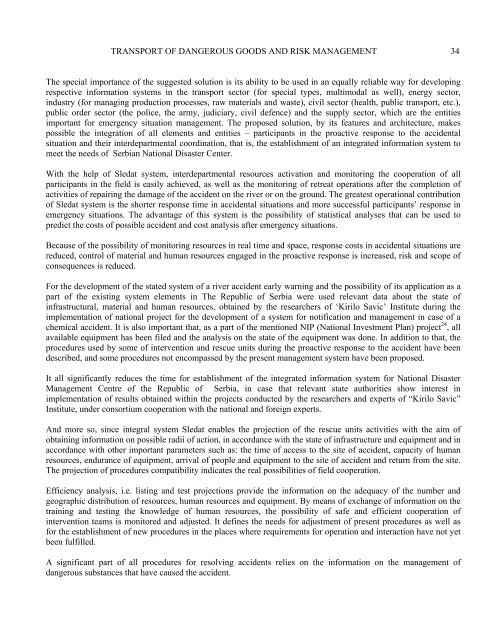transport of dangerous goods and risk management - Kirilo SaviÄ
transport of dangerous goods and risk management - Kirilo SaviÄ
transport of dangerous goods and risk management - Kirilo SaviÄ
Create successful ePaper yourself
Turn your PDF publications into a flip-book with our unique Google optimized e-Paper software.
TRANSPORT OF DANGEROUS GOODS AND RISK MANAGEMENT 34The special importance <strong>of</strong> the suggested solution is its ability to be used in an equally reliable way for developingrespective information systems in the <strong>transport</strong> sector (for special types, multimodal as well), energy sector,industry (for managing production processes, raw materials <strong>and</strong> waste), civil sector (health, public <strong>transport</strong>, etc.),public order sector (the police, the army, judiciary, civil defence) <strong>and</strong> the supply sector, which are the entitiesimportant for emergency situation <strong>management</strong>. The proposed solution, by its features <strong>and</strong> architecture, makespossible the integration <strong>of</strong> all elements <strong>and</strong> entities – participants in the proactive response to the accidentalsituation <strong>and</strong> their interdepartmental coordination, that is, the establishment <strong>of</strong> an integrated information system tomeet the needs <strong>of</strong> Serbian National Disaster Center.With the help <strong>of</strong> Sledat system, interdepartmental resources activation <strong>and</strong> monitoring the cooperation <strong>of</strong> allparticipants in the field is easily achieved, as well as the monitoring <strong>of</strong> retreat operations after the completion <strong>of</strong>activities <strong>of</strong> repairing the damage <strong>of</strong> the accident on the river or on the ground. The greatest operational contribution<strong>of</strong> Sledat system is the shorter response time in accidental situations <strong>and</strong> more successful participants’ response inemergency situations. The advantage <strong>of</strong> this system is the possibility <strong>of</strong> statistical analyses that can be used topredict the costs <strong>of</strong> possible accident <strong>and</strong> cost analysis after emergency situations.Because <strong>of</strong> the possibility <strong>of</strong> monitoring resources in real time <strong>and</strong> space, response costs in accidental situations arereduced, control <strong>of</strong> material <strong>and</strong> human resources engaged in the proactive response is increased, <strong>risk</strong> <strong>and</strong> scope <strong>of</strong>consequences is reduced.For the development <strong>of</strong> the stated system <strong>of</strong> a river accident early warning <strong>and</strong> the possibility <strong>of</strong> its application as apart <strong>of</strong> the existing system elements in The Republic <strong>of</strong> Serbia were used relevant data about the state <strong>of</strong>infrastructural, material <strong>and</strong> human resources, obtained by the researchers <strong>of</strong> ‘<strong>Kirilo</strong> Savic’ Institute during theimplementation <strong>of</strong> national project for the development <strong>of</strong> a system for notification <strong>and</strong> <strong>management</strong> in case <strong>of</strong> achemical accident. It is also important that, as a part <strong>of</strong> the mentioned NIP (National Investment Plan) project 24 , allavailable equipment has been filed <strong>and</strong> the analysis on the state <strong>of</strong> the equipment was done. In addition to that, theprocedures used by some <strong>of</strong> intervention <strong>and</strong> rescue units during the proactive response to the accident have beendescribed, <strong>and</strong> some procedures not encompassed by the present <strong>management</strong> system have been proposed.It all significantly reduces the time for establishment <strong>of</strong> the integrated information system for National DisasterManagement Centre <strong>of</strong> the Republic <strong>of</strong> Serbia, in case that relevant state authorities show interest inimplementation <strong>of</strong> results obtained within the projects conducted by the researchers <strong>and</strong> experts <strong>of</strong> “<strong>Kirilo</strong> Savic”Institute, under consortium cooperation with the national <strong>and</strong> foreign experts.And more so, since integral system Sledat enables the projection <strong>of</strong> the rescue units activities with the aim <strong>of</strong>obtaining information on possible radii <strong>of</strong> action, in accordance with the state <strong>of</strong> infrastructure <strong>and</strong> equipment <strong>and</strong> inaccordance with other important parameters such as: the time <strong>of</strong> access to the site <strong>of</strong> accident, capacity <strong>of</strong> humanresources, endurance <strong>of</strong> equipment, arrival <strong>of</strong> people <strong>and</strong> equipment to the site <strong>of</strong> accident <strong>and</strong> return from the site.The projection <strong>of</strong> procedures compatibility indicates the real possibilities <strong>of</strong> field cooperation.Efficiency analysis, i.e. listing <strong>and</strong> test projections provide the information on the adequacy <strong>of</strong> the number <strong>and</strong>geographic distribution <strong>of</strong> resources, human resources <strong>and</strong> equipment. By means <strong>of</strong> exchange <strong>of</strong> information on thetraining <strong>and</strong> testing the knowledge <strong>of</strong> human resources, the possibility <strong>of</strong> safe <strong>and</strong> efficient cooperation <strong>of</strong>intervention teams is monitored <strong>and</strong> adjusted. It defines the needs for adjustment <strong>of</strong> present procedures as well asfor the establishment <strong>of</strong> new procedures in the places where requirements for operation <strong>and</strong> interaction have not yetbeen fulfilled.A significant part <strong>of</strong> all procedures for resolving accidents relies on the information on the <strong>management</strong> <strong>of</strong><strong>dangerous</strong> substances that have caused the accident.








